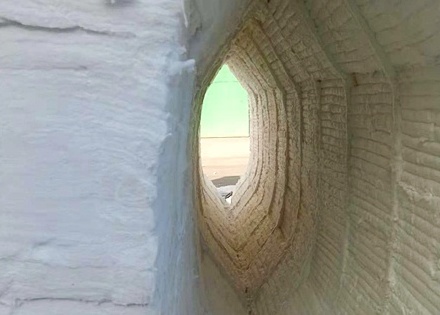Table of Contents
Anchor-Tech Ceramic Fiber Modules for Flue Gas Denitrification

1. Introduction to Flue Gas Denitrification
Flue gas denitrification is a response measure to the national energy conservation and emission reduction to meet the emission standards of atmospheric pollutants. There are two methods for flue gas denitrification, SCR (catalyst) denitrification and SNCR (catalyst-free) denitrification. The former has high cost and high denitrification rate; the latter has low cost and unstable denitrification rate. The former is currently more widely used.

2. Ceramic fiber module for flue gas denitrification insulation material
Flue gas denitrification devices are usually placed in the air or on the roof of a factory building in the form of a flue, so lightweight insulation materials are more suitable and relatively popular. At present, the lightweight insulation materials with moderate prices and acceptable to most enterprises are glass wool and aluminum silicate fiber wool (i.e. ceramic fiber wool), but the former is not suitable for use at temperatures below 400°C, while the latter is used at temperatures between 800 and 1400°C. Customers can choose ceramic fiber wool of appropriate material for insulation according to the flue temperature.
(1) SCR denitrification: The denitrification temperature is about 320℃, and the flue gas temperature is 420℃~430℃. Because sparks may occasionally appear in the flue gas, it is necessary to select high-temperature insulation materials with a temperature resistance of more than 1000℃. Anchor-Tech standard ceramic fiber modules can be used, that is, modules made of Anchor-Tech standard ceramic fiber blankets ;
(2) SNCR denitrification: The temperature of the denitrified flue gas is around 900℃~1100℃. Anchor-Tech high-aluminum/zirconium-containing ceramic fiber modules , i.e. modules made of Anchor-Tech high-aluminum/zirconium-containing ceramic fiber blankets, can be used.

3. Advantages of ceramic fiber flue insulation lining for flue gas denitrification
(1) Lightweight, the average unit density of the furnace lining is 230Kg/m³, which is easy to hoist; and the requirements for high-temperature flue support are relatively low;
(2) The Anchor-Tech ceramic fiber modules used for denitrification have good thermal and chemical stability, and the denitrification flue insulation lining has a long service life;
(3) The thermal insulation effect is good. The Anchor-Tech ceramic fiber modules are in a pre-compression state before installation. After the flue lining is completed, the expansion of the modules makes the furnace lining seamless and can compensate for the shrinkage of the fiber lining to improve the integrity and thermal insulation of the fiber lining.
(4) The installation is convenient and quick, the construction period is short, saving construction time and reducing construction costs.


